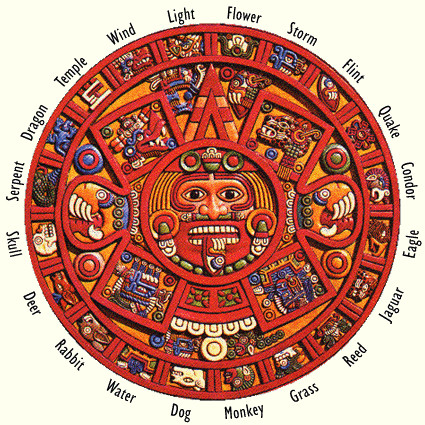
by John P. Pratt
28 May 2019, 13 Water (SR), 1 Birth (M), 0 Lord (Ma), Hero (S)
©2019 by John P. Pratt. All rights Reserved.
|
1. Holy Days 1.1 The Veintena 1.2 Hebrew and Enoch 1.3 Lunar Mansions 2. Combined Meanings 3. Summary of Meanings 4. Seven Angels 5. Conclusion Notes |
The patriarch Jacob had a dream of angels ascending and descending a ladder from heaven to earth (Gen. 28:12). That ladder is often interpreted as representing steps needed to return to God.[1] Mayan priests described the meaning of the glyphs of the 20-day cycle (veintena) of the Sacred Round (see Figure 1) as being in a circle because the first ten days represent mankind's life from conception to anguish as a spirit in the underworld at the lowest point (Dog) and then comes the first rung on a ladder leading back up to heaven, arriving on the day Lord (Flower). Both Jacob and Mayans refer to ladders to heaven. Could they be related?
 |
Let us review previous work showing how the twenty day signs of the veintena are related to holy days on the Hebrew, Enoch, Mercury, Venus, and Mars Calendars. Then we will be prepared to appreciate the new contribution of the lunar mansions of the Star Calendar.
The 20-day cycle of glyphs or day signs is one of the two cycles which form the Sacred Round (SR) of 260 days held sacred by most Native American tribes. For the purposes of this article, nothing else need be understood about the Sacred Round; it is only the 20-day veintena which is discussed. The Mayan priests explained to conquering Spanish priests that these twenty little pictures represent the days in the life and afterlife of mankind.
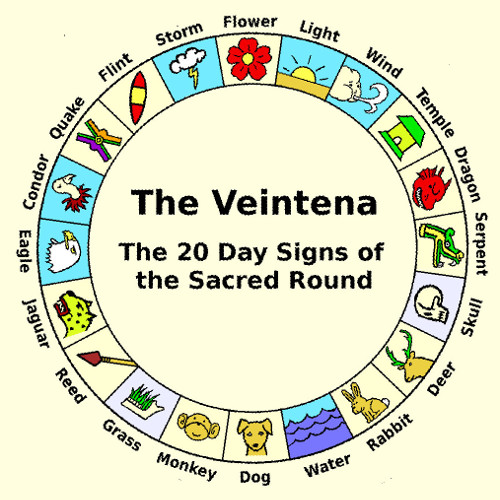 |
One author summarizes the meaning of the day signs of the veintena as follows (with my English day names added in square brackets because she assumes you know the Mayan names --JPP):
These twenty days, the footprints of the god, turn out to be nothing less than the symbolic representation of man's spiritual pilgrimage. They are twenty steps up and down the ladder, beginning with Imix, from Im, the womb. The first day [Light: Conception] starts the child off on his journey through life. On the second [Wind: Quickening], Ik, spirit or breath is bestowed upon him when he is still within the womb. On the third [Temple: Birth], Akbal, he is born ... On the fourth [Dragon: Adult], Kan, he begins to know evil; and on the fifth [Serpent: Rebirth], Chicchan, he gathers together all of the experiences of his life. On the sixth [Skull: Death], Cimi, he dies. On the seventh [Deer: Spirit World], Man-Ik, from Manzal-Ik (pass through the spirit), he overcomes death.
"Now he must plunge into the lower regions; he must struggle to overcome the material state. This is the eighth day [Rabbit: Materialism], Lamat, the sign of Venus. On the ninth day [Water: Triumph], Muluc, he reaps the reward of his effort; and on the tenth [Dog: Anguish], Oc, he enters fully into the uttermost depths of matter in order, on the eleventh day [Monkey: First Rung], Chuen, to burn without flame. In other words, he suffers the greatest possible agony. On the twelfth day [Grass: Rising], Eb, he begins to climb the ladder, a long process which continues through the thirteenth day [Reed: Resurrection], Ben, (which represents growing maize) until on the fourteenth day [Jaguar: Sanctify], Ix (the Jaguar god), he is washed entirely clean. This allows him on the fifteen day [Eagle: Fulness], Men, to be come perfect, but still he does not possess the full light of consciousness, which comes to him on the sixteenth day [Condor: Awareness], Cib. On the seventeenth day [Quake: Motion], C'haban, he shakes off the last traces of ash clinging to him from the material world. 'Ash' is the word specifically used and it suggests that he has been purged by fire. On the eighteenth day [Flint: Perfection], Edznab, he is made perfect. By the nineteenth day [Storm: Lightning], Cauac, his divine nature is manifest. On the twentieth and last day [Flower: Lord], Ahau (god), he becomes one with the divinity."[5]
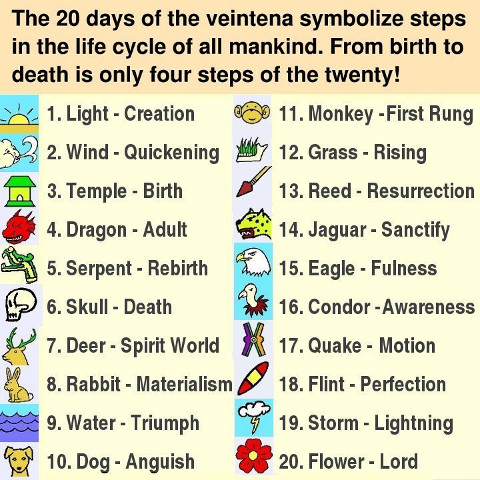 |
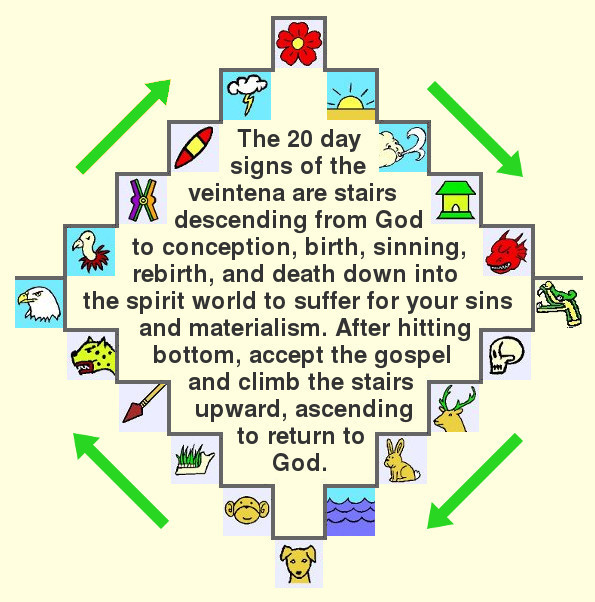 |
When the Enoch Calendar (E) was discovered, it immediately became clear that it was a counterpart to the Hebrew Calendar (PH). In particular, they both had exactly the same holy days in the same order and usual even on the same days of the twelve months. Then five years ago it became clear that twenty of the holy days on those two calendars also lined up with the twenty day signs of the veintena.[3] That was a huge discovery. It could not possibly be due to chance that the principal meanings for those days to all "just happen" to match up with the 20 days signs in the same order.
Moreover, even though the planetary calendars of Mercury, Venus, and Mars only have nine holy days, all of those can be matched with 9 of the 20 day signs and in the same order!
Later a paper was written about the 28 lunar mansions.[4] It was intended to be merely a scientific paper about a curiosity from the ancients who had carefully listed 28 stars, called "lunar mansions" or "lunar stations", which were roughly evenly spaced around the ecliptic, marking the progress of the moon each day. My only motivation for writing the paper at all was that, for some strange reason, these stars all seemed be on star days on which sacred events occurred. Thus, they came to be listed as holy days on the two Star Calendars: Star (S) and Uniform Star (US).
In the course of writing that article it suddenly became clear that the same phenomenon had repeated with the Star Calendars of holy days aligning with the 20 days of the veintena cycle. That is, 20 of the 28 lunar mansion stars also had the same symbolism as the veintena day signs and holy days on the Hebrew and Enoch Calendars! What was becoming clear is that different calendars not only include these steps of life, but apparently all of the sacred calendars include these steps in the same order![6]
Most readers can now skip details in Section 2 except for Figure 4 and go directly to the summary of results in Section 3 and application to the seven angels in Section 4!
Given that these four sacred calendars all tell the same story of ladders down and up from heaven, one can combine their symbolism (see Figure 4) to get an increased understanding of the meaning of each step. The rest of this section is a detailed look at each of the twenty day signs compared to the corresponding holy days on the Hebrew, Enoch, and Star Calendars.
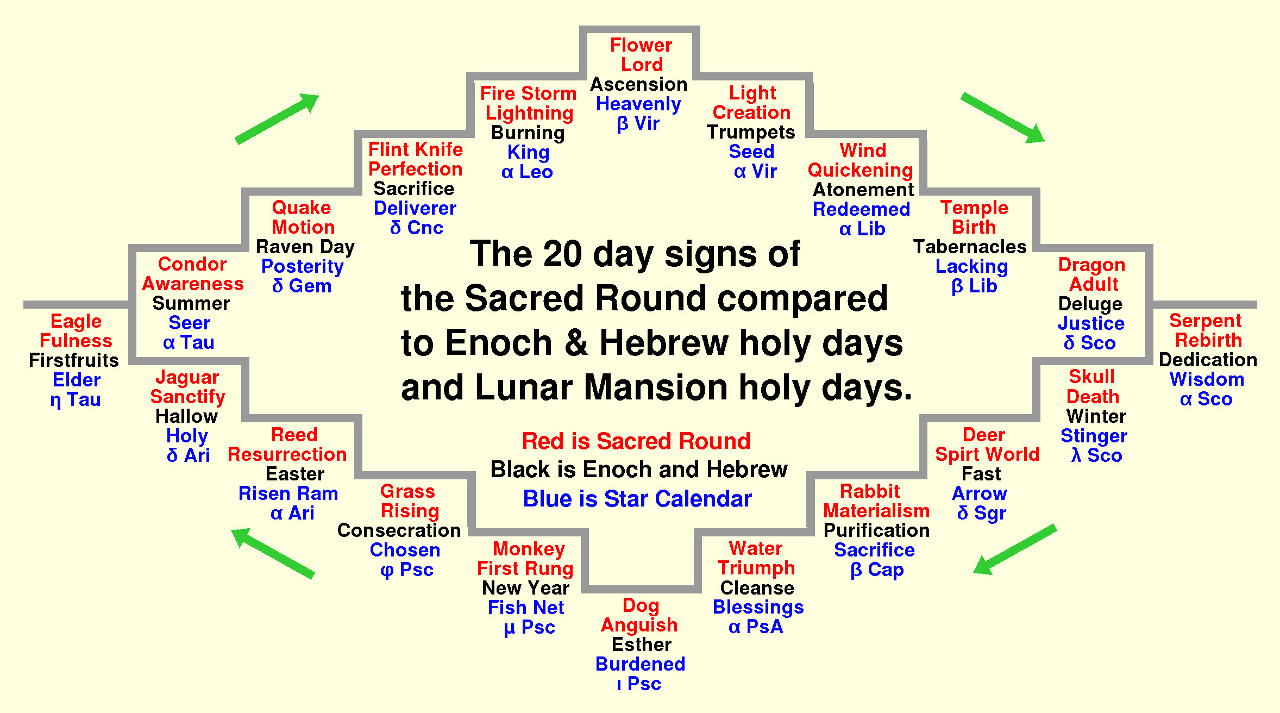 |
 1. Light. Light is the first day of the 20-day cycle and represents the day on which man
begins his journey through life, referring to the day of conception. The Mixtec glyph
is an alligator or crocodile, which might represent the embryo in the womb.
The Mayan name "Imix" apparently derives from Ix, meaning "womb" and their glyph is said to
represent a water lily floating in water. It is
usually called "Alligator" or "Crocodile", but "Light" seems better for the following reason.
1. Light. Light is the first day of the 20-day cycle and represents the day on which man
begins his journey through life, referring to the day of conception. The Mixtec glyph
is an alligator or crocodile, which might represent the embryo in the womb.
The Mayan name "Imix" apparently derives from Ix, meaning "womb" and their glyph is said to
represent a water lily floating in water. It is
usually called "Alligator" or "Crocodile", but "Light" seems better for the following reason.
The 20-day cycle apparently originated with the ancient Olmecs, over 1,000 years before the Mayans and Aztecs. Their first glyph was the sun. One of the modern day derivatives from the Olmec (the Tequistl), calls their glyph "Light," which most likely was the meaning of the original sun glyph. "Light" might be the best interpretation, referring either to a pre-mortal stage as a "being of light," or perhaps to the day of conception when the "spark" of life ignited. My word to summarize its meaning is either "Creation" or "Conception".
As for the Hebrew and Enoch Calendars, the Feast of Trumpets is on the first day of autumn on both calendars. It is a day when trumpets are sounded to herald coming events. This is consistent with the meaning of "Creation", which often refers to the day a project is announced.
Now adding in the lunar mansion, the one that matches for a starting point is the "Seed of Woman" (Alp Vir), being the wheat grain held in her hand, which represents her Son to be born. So that is a perfect match indeed. Figure 4 summarizes these results in the red (SR), black (PH,E), and blue (S) letters under the first step down from the top.
 2. Wind. The second day of the veintena is Wind which symbolizes the day when the spirit enters into the child's body in the womb, called "Quickening" as my summary word. The second Hebrew and Enoch holy day of autumn is the Day of Atonement. That is the most spiritual holy day of the year. Of the original seven holy days given in the Law of Moses, there were six feast days and one fast day, the Day of Atonement. Thus, it is a day to seek to have the Spirit of God and hence is an excellent match for Quickening.
2. Wind. The second day of the veintena is Wind which symbolizes the day when the spirit enters into the child's body in the womb, called "Quickening" as my summary word. The second Hebrew and Enoch holy day of autumn is the Day of Atonement. That is the most spiritual holy day of the year. Of the original seven holy days given in the Law of Moses, there were six feast days and one fast day, the Day of Atonement. Thus, it is a day to seek to have the Spirit of God and hence is an excellent match for Quickening.
The star holy day which matches is "Redeemed" (Alp Lib) which refers to the price paid by the Redeemer to pay for our sins because we were weighed in the balance and found wanting. Redeemed is the brighter star in the lower tray.
 3. Temple. The third glyph Temple represents "Birth" (my summary word), being the day on which ones receives the temple of the body. On the Hebrew and Enoch Calendars is the first day of the Feast of Tabernacles, on which one lives in a tabernacle (tent) for a week. That week represents life, with tabernacle being a portable temple. Adam was born on the first day of Tabernacles and died on the last day.
3. Temple. The third glyph Temple represents "Birth" (my summary word), being the day on which ones receives the temple of the body. On the Hebrew and Enoch Calendars is the first day of the Feast of Tabernacles, on which one lives in a tabernacle (tent) for a week. That week represents life, with tabernacle being a portable temple. Adam was born on the first day of Tabernacles and died on the last day.
On the Star Calendar the star is "Lacking" (Bet Lib), which is the higher tray of the Balance, indicating that it is short of the price which must be paid. It represents the predicament of mankind, from the time of birth into a fallen world.
 4. Dragon. The fourth day of the veintena is Dragon symbolizing the day when evil enters a child's life, usually at age eight. Before that age, the Mayans believed that a child was pure and could not be tempted. This glyph is usually called "Lizard" or "Iguana". The name "Dragon" used in my work comes from the Cherokee name, which seems to capture the meaning well. They associate this glyph with the constellation of the Dragon (Draco). My summary word for the meaning is "Adult", when one has outgrown the innocence of childhood and become accountable for his sins.
4. Dragon. The fourth day of the veintena is Dragon symbolizing the day when evil enters a child's life, usually at age eight. Before that age, the Mayans believed that a child was pure and could not be tempted. This glyph is usually called "Lizard" or "Iguana". The name "Dragon" used in my work comes from the Cherokee name, which seems to capture the meaning well. They associate this glyph with the constellation of the Dragon (Draco). My summary word for the meaning is "Adult", when one has outgrown the innocence of childhood and become accountable for his sins.
Is there such an evil day on the Hebrew and Enoch Calendars? Yes, but it is not a day of celebration, nor even mourning. It is largely unnoticed, but it kept coming up over and over in the study of sacred calendars. It is the day on which the Great Deluge began, the day 17 Heshvan (PH) (Gen. 7:11-12). That day had no special name to my knowledge, so in my work it is called "Deluge Day".
It corresponds to the star day "Justice" (Del Sco) being dealt out by the the Great Judge (Scorpion). The serpent constellations of the Serpent, Scorpion, and Draco can represent either God or Satan when either is fulfilling a role of judging or punishing. The underwater monsters only represent evil beings. It was God who judged the wickedness of mankind and sentenced nearly all to death. This star too is a perfect match with the other holy days.
 5. Serpent. The fifth step of the veintena, the Serpent, represents "Rebirth" (my summary word), being "born again" to righteousness after having finished the "natural man" stage of evil. The serpent was probably chosen because of it shedding its old skin, actually crawling out of it. That is really unusual for vertebrates. So is there any Hebrew holy day representing "Rebirth"?
5. Serpent. The fifth step of the veintena, the Serpent, represents "Rebirth" (my summary word), being "born again" to righteousness after having finished the "natural man" stage of evil. The serpent was probably chosen because of it shedding its old skin, actually crawling out of it. That is really unusual for vertebrates. So is there any Hebrew holy day representing "Rebirth"?
The next holy day on the Hebrew and Enoch Calendars is the Feast of Dedication also known as the Festival of Lights. That commemorates the rededication of the Temple in 165 BC. That seems a good fit indeed because the temple was being "born again".
On the Star Calendar it is the very bright star "Wisdom" (Alp Sco) at the heart of the Scorpion. That represents the wisdom of the serpent (a scorpion is considered a serpent in the Biblical taxonomy), which is to judge timing well of when to strike (Ecc. 8:5). Wisdom in this case may refer to being wise enough to choose good over evil, which leads to rebirth.
Before continuing, note that there are five glyphs and holy days per season. On the Aztec calendar stone, the veintena is clearly divided into four equal parts (see Figure 1), just as on the Enoch Calendar the year is divided into four equal parts. That means that figures 6-10 should represent winter, 11-15 spring, and 16-20 summer.
 6. Skull. Using that template, the sixth day sign Skull, shown as a human skull and representing "Death", would correspond to the first day of winter on the Enoch (1 Winter) and Hebrew Calendar (1 Tebeth, called "Winter" in my work). A moment's reflection shows that is fitting because it represents the winter solstice, when the sun reaches its father point south as it rises. It could be said to die there.
6. Skull. Using that template, the sixth day sign Skull, shown as a human skull and representing "Death", would correspond to the first day of winter on the Enoch (1 Winter) and Hebrew Calendar (1 Tebeth, called "Winter" in my work). A moment's reflection shows that is fitting because it represents the winter solstice, when the sun reaches its father point south as it rises. It could be said to die there.
The corresponding star day is that of the "Stinger" (Lam Sco) of the Scorpion. That is truly a bull's-eye to represent death!
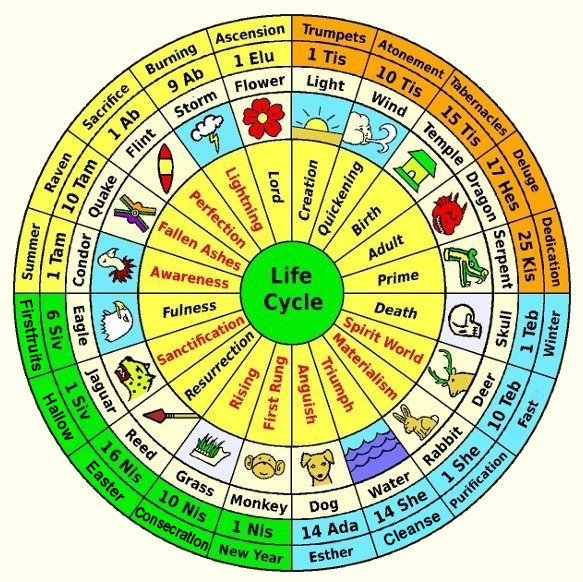 |
 7. Deer. The seventh day sign is Deer, which the Mayan priests said symbolized the spirit entering the "Spirit World" (my summary words) after death. Perhaps the swift moving deer was used to represent the swiftness with which spirits can move from place to place.
7. Deer. The seventh day sign is Deer, which the Mayan priests said symbolized the spirit entering the "Spirit World" (my summary words) after death. Perhaps the swift moving deer was used to represent the swiftness with which spirits can move from place to place.
What holy day would represent this day on the Enoch and Hebrew Calendars? Each of the four seasons has a "fast day" or a "setting apart to be sacrificed day" associated with the tenth day of that first month of each season. In the case of winter, the tenth of that month was declared by the Lord to two separate prophets to be a day remembered as when Nebuchadnezzar began his siege of Jerusalem (Jer. 52:4, Ezek. 24:1-2). That day led to its downfall, which eventually sent many people to the spirit world. That is the holy day from the Hebrew Calendar to match Deer. In my work it is called the "Winter Fast" or simply "Fast". The word "fast" has a double meaning, both to abstain from food and also "to move quickly" as is the symbolism of the Deer.
The corresponding star day is "Bow Grip" (Del Sgr). That name is to remind one of the location in the Archer, but the star can apparently be considered as part of either the Archer (hand), the Bow (grip), or the Arrow. In this case, it appears to be the arrow because it represents swiftness, so that is the name listed in Figure 4.
 8. Rabbit. Rabbit is the eighth day glyph in the veintena. The Mayan priests said it represented man's spirit in the spirit world struggling to overcome connections to the material world. These could be both from carnality (for which the rabbit is a well known representative of promiscuity) and also attachments to material things. Many people in near death experiences report seeing others with material cravings such as for smoking and drinking and ghosts attached to their former houses. Indeed, this is apparently common enough to merit a special day on veintena life cycle. My word for what it represents is "Materialism".
8. Rabbit. Rabbit is the eighth day glyph in the veintena. The Mayan priests said it represented man's spirit in the spirit world struggling to overcome connections to the material world. These could be both from carnality (for which the rabbit is a well known representative of promiscuity) and also attachments to material things. Many people in near death experiences report seeing others with material cravings such as for smoking and drinking and ghosts attached to their former houses. Indeed, this is apparently common enough to merit a special day on veintena life cycle. My word for what it represents is "Materialism".
The corresponding day proposed for the Hebrew and Enoch Calendars is the holy day which is the first day of the tenth month (usually in January). The first day of each month is a minor holy day, but most without special names. This day is associated somewhat with priests. For example, this was the day of Levi's death (PH). In that sense, it could be related to abstinence from physical attachments. In my work this holy day is called "Purification" (E, PH).
 9. Water. According to the Mayan priests, the ninth day of the veintena, Water, represents the day on which one "reaps the reward of his effort" of overcoming materialism. That concept is summarized as "Triumph" in my work. This is also a day which probably represents baptism, being, for example, the day on which Jesus was baptized. In a way that matches triumphing over materialism, as baptism is often considered an outward sign of an inner commitment to keep the commandments.
9. Water. According to the Mayan priests, the ninth day of the veintena, Water, represents the day on which one "reaps the reward of his effort" of overcoming materialism. That concept is summarized as "Triumph" in my work. This is also a day which probably represents baptism, being, for example, the day on which Jesus was baptized. In a way that matches triumphing over materialism, as baptism is often considered an outward sign of an inner commitment to keep the commandments.
.jpg) |
The star day associated with this day sign is "Blessings" (Alp PsA) because it is found at the end of the stream of water being poured out onto the head of the Southern Fish, which represents Christians. Again we have a bull's-eye because both the glyph and the constellation are illustrations of water!
 10. Dog. At the lowest point of the circle, the tenth glyph Dog (a guide through the underworld like the Egyptian jackal-headed Anubis) represents the day one "enters fully into the uttermost depths of matter." It seems to represent agony and anguish, and suffering in hell for sins or having intense remorse for them. The point is made that the circular form for the veintena is important, showing the Dog is at the lowest point. My summary word for this day sign is "Anguish".
10. Dog. At the lowest point of the circle, the tenth glyph Dog (a guide through the underworld like the Egyptian jackal-headed Anubis) represents the day one "enters fully into the uttermost depths of matter." It seems to represent agony and anguish, and suffering in hell for sins or having intense remorse for them. The point is made that the circular form for the veintena is important, showing the Dog is at the lowest point. My summary word for this day sign is "Anguish".
What is the Hebrew and Enoch holy day near the end of winter and the last one of that quarter year? It is the Feast of Esther, which occurs on the 14th and 15th day of Late Winter (E). That day celebrates what did not happen, namely the destruction of the Jewish people in her realm at the time of her reign as queen. Certainly that would have been a day of great suffering in anticipation of the expected destruction.
The corresponding day on the Star Calendar is "Burdened Back" (Iot Psc), a star in the Christian fish named "Called" (Western Fish of Pisces). Thus, the name is associated with the burdens which God's people must bear and is a good match for the Feast of Esther and the Dog.
 11. Monkey. The Monkey begins the upward cycle after having hit rock bottom. This day begins the next set of five days of spring. The day of the life cycle is called "First Rung" in my work, calling to mind the Mayan image of beginning one's ascent back to heaven on a ladder. That fits with being the holy day New Year (E,PH), also a new beginning.
11. Monkey. The Monkey begins the upward cycle after having hit rock bottom. This day begins the next set of five days of spring. The day of the life cycle is called "First Rung" in my work, calling to mind the Mayan image of beginning one's ascent back to heaven on a ladder. That fits with being the holy day New Year (E,PH), also a new beginning.
On the Star Calendar it corresponds to the "Fish Net" (Mu Psc) which the Ram is casting out to sea to be a fisher of men. The constellation of the Fishes (Pisces) has two versions. In the traditional version from the Greeks it consists of two fish tied by cords to the Sea Monster which represents Death. The Ram breaks the cords at the time of their resurrections. In the alternate version the two cords are edges of the gospel net which is being cast out to catch Christians. That is the symbolism of this star which is tied to the gospel being preached. In the case of it being the First Rung, it would refer to the gospel being preached to the spirits in the spirit prison. Accepting Jesus Christ and Lord and Savior would be the first step rising upward.
 12. Grass. The glyph Grass is perhaps the most impressive symbolism. It is a picture of young new grass growing out of the jawbone of a skull. It clearly shows life beginning to grow from death! The priests said it worked together with the next glyph, Reed (which represents resurrection). It apparently is some preparatory step for resurrection. My summary word for the meaning of this glyph is "Rising", which fits both the grass growing and rising again after death.
12. Grass. The glyph Grass is perhaps the most impressive symbolism. It is a picture of young new grass growing out of the jawbone of a skull. It clearly shows life beginning to grow from death! The priests said it worked together with the next glyph, Reed (which represents resurrection). It apparently is some preparatory step for resurrection. My summary word for the meaning of this glyph is "Rising", which fits both the grass growing and rising again after death.
Following the pattern of the tenth day of the seasonal month in the Enoch and Hebrew Calendars, this day would be the tenth day of spring, called "Consecration" in my work. It is the day on which the Passover lamb is chosen, or "set apart", to be the sacrifice. It was the birth day of Isaac, who filled a similar role. The concept of consecration seems good to be the second rung on the ladder upward.
The lunar mansion star is "Chosen" (Phi Psc), which is the more spiritually advanced of the two Fishes caught in the gospel net. The other is "Called" in the sense that "Many are called but few are chosen." "Chosen" is the fish picked out of the net by the angels while the other is cast away (Mat 13:47-49). Thus, it is an excellent match for both "Consecration" (PH,E), and "Rising" (SR).
 13. Reed. The day sign Reed is a continuation of the grass growing from the skull, being the next rung on the ladder. The reed was the kind used for making arrows; the Mixtecs used an arrow for this glyph. The reed is also suggestive of fully grown grass. This glyph is identified in my work as representing "Resurrection".
13. Reed. The day sign Reed is a continuation of the grass growing from the skull, being the next rung on the ladder. The reed was the kind used for making arrows; the Mixtecs used an arrow for this glyph. The reed is also suggestive of fully grown grass. This glyph is identified in my work as representing "Resurrection".
As for as the Hebrew and Enoch Calendars, there is a clear "Resurrection" date indicated, although it is not considered a Hebrew holy day by Jews. It is the Sunday after Passover. It is the day on which Jesus resurrected. In my work it is called Easter, even on the Hebrew calendar, because that is the name it is commonly known by and because the Hebrew day nearly always coincides with the Christian Easter. The Hebrews call it the "Waving of the Omer", when the firstfruits (1 Cor. 15:20) of the ground (barley) were waved before the Lord (Lev. 23:11).
The corresponding star day is "Risen Ram" (Alp Ari), the brightest star in Aries which represents the fully developed Ram, rather than the Lamb of God to be sacrificed. The Savior resurrected on that very star day (S & US), which was indeed Easter Sunday (S). Thus, it is another bull's-eye date. Keep in mind that all of these holy days are taken in order, five per season.
 14. Jaguar. The Jaguar day sign was said by the priests to represent the day on which one is "washed entirely clean," apparently referring to baptism. It was also believed that the jaguar symbolized an order of priesthood that was the one associated with baptism. The Jaguar Priest was very powerful in Central America. There are several holy books called the books of Chilam Balaam, which translates to Jaguar Priest. Figure 6 shows a Jaguar Priest sitting on the inverted Mixtec glyph for (living) Water. In my work this life cycle day name is "Sanctify".
14. Jaguar. The Jaguar day sign was said by the priests to represent the day on which one is "washed entirely clean," apparently referring to baptism. It was also believed that the jaguar symbolized an order of priesthood that was the one associated with baptism. The Jaguar Priest was very powerful in Central America. There are several holy books called the books of Chilam Balaam, which translates to Jaguar Priest. Figure 6 shows a Jaguar Priest sitting on the inverted Mixtec glyph for (living) Water. In my work this life cycle day name is "Sanctify".
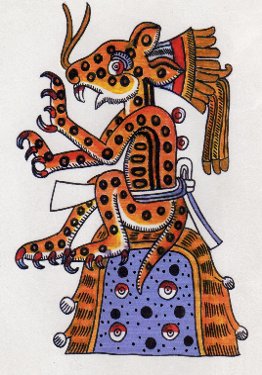 |
If so, then Jaguar is a perfect candidate for baptism, the first ordinance of the gospel of Jesus Christ. "Washed clean" sure sounds like baptism. Also notice the corresponding days of each quarter year. The Jaguar is opposite the Dragon in the circle, and the purpose of baptism is to wash one clean from the sins introduced into life by the Dragon. Moreover, the day Water is in the same slot in the second quarter, it is a natural for baptism. When we get to the glyph in the last quarter, it represents Fire and could well represent a baptism of fire.
If such a clear relationship of an ordinance to the problem it resolves occurred for all of these last seven figures, then it would be clear that these last seven are ordinances. But alas, that does not seem to be the case.
As this article is being written, a new explanation emerged for the difference between the last seven rungs on the ladder to heaven and all of the previous steps. The first 13 steps all concern individual progress, whereas the last seven steps all refer to serving others! This interpretation fits all of the last seven steps and is now being tentatively adopted. Accordingly, in the case of Jaguar, the meaning is not the ordinance of baptism received by the individual, which is more likely Water, but it is becoming a priest to baptize others!
The name "Sanctify" also matches the corresponding Hebrew holy day, being the first day of the last month of spring. That was the day that the children of Israel with Moses arrived at the wilderness of Sinai (Exo. 19:1). They then were commanded to "sanctify" themselves to prepare for the receiving of the Ten Commandments. The name for this Hebrew day in my work is "Hallow" to remember that archetypal event.
The corresponding Star Calendar day is "Holy" (Del Ari), being named such because it is a star in the holy Lamb of God and several important sacred events occurred on that day. Again that is a perfect match!
 15. Eagle. Eagle, the next day sign, was said to represent the day on which one "becomes perfect." It apparently also symbolized a higher priesthood order than the Jaguar. The word chosen for the meaning of this sign is "Fulness". That could refer to receiving a "fulness" of the priesthood. Again, the priesthood is a service brotherhood, so this gift is to be used to help others.
15. Eagle. Eagle, the next day sign, was said to represent the day on which one "becomes perfect." It apparently also symbolized a higher priesthood order than the Jaguar. The word chosen for the meaning of this sign is "Fulness". That could refer to receiving a "fulness" of the priesthood. Again, the priesthood is a service brotherhood, so this gift is to be used to help others.
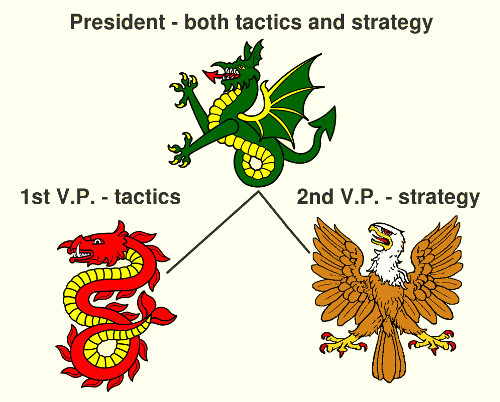 |
The Hebrew and Enoch holy day to complete the set of five for spring is the Feast of Firstfruits, also known as Pentecost. It occurs exactly seven weeks after Easter, and hence is also called the Feast of Weeks. In the early Christian church, many were filled with the Holy Spirit on the Day of Pentecost. So all of these are consistent with "Fulness".
The corresponding Star Calendar day is "Elder" (Eta Tau), which is indeed the star day for Firstfruits (S) during the current age now, so that is a good match! The name "Elder" was chosen to have a double meaning. First, it suggests the priesthood held by an elder in the Church of Christ. Second, the star is the brightest star in the Seven Sisters (Pleiades). Modern astronomers call it Alcyone, but that appears to be incorrect because the most important of the sisters was Maia. That should be the star's Greek name. Maia was the eldest sister and was the mother of Hermes. Thus, the name "Elder" was chosen because she is indeed the "elder" of the two sisters represented in the Star Calendar. The Seven Sisters apparently represent the seven Chief Angels of God. If so, Maia would be Adam, the eldest, and Electra would be Enoch (Hermes).
 16. Condor. Most tribes saw this figure as a vulture, but originally it was
probably a condor (in the vulture family), revered as the only bird which flies higher than the eagle. On this day it was said that one was endowed with the "full light of consciousness." Hence, the sign is called Condor in my work and the meaning summarized by "Awareness".
16. Condor. Most tribes saw this figure as a vulture, but originally it was
probably a condor (in the vulture family), revered as the only bird which flies higher than the eagle. On this day it was said that one was endowed with the "full light of consciousness." Hence, the sign is called Condor in my work and the meaning summarized by "Awareness".
Why a vulture? The head of the vulture is designed so that it can be put inside a dead carcass to eat with no adverse effects. Notice that the Skull is opposite the Condor in the circle. A spiritually aware person can see into the spirit realm at will, so the symbolism may be that the Condor can look into the world of the dead. It is interesting to note that the Mayans made the point that one could be "perfect" (day 15) and yet still not be aware (day 16).
On the Hebrew and Enoch Calendars, this day is the first day of the summer quarter. It has no special name on the Hebrew Calendar, so it is called simply "Summer" (PH) in my work. On the Enoch Calendar it is 1 Summer.
On the Star Calendar the day is that of the Seer (Alp Tau), which is a perfect match! Having both gifts of seeing into the spirit world (prophet) and also being able to discern truth (know past, present, and future) as a revelator is a high gift indeed (Mosiah 8:15-16).[7] This is an excellent example of a gift which goes beyond being perfect (in the sense of being whole, with perfect integrity of following the spirit that moves in all things). Thus, it helps explain the meaning of the day sign more fully and is another great match. Moreover, the seer is to use his gift to serve others and help them ascend the ladder.
 17. Quake. The next glyph Quake symbolizes shaking, earthquakes, and motion in general. It is said to be the day when one "shakes off the last traces of ash clinging to him from the material world." It is called "Motion" by several tribes, which is my summary word to describe its meaning. The glyph may represent a rattle of some sort which one shakes. It also seems intimately tied to the idea of life in general, which is associated with animals and plants which can grow and move.
17. Quake. The next glyph Quake symbolizes shaking, earthquakes, and motion in general. It is said to be the day when one "shakes off the last traces of ash clinging to him from the material world." It is called "Motion" by several tribes, which is my summary word to describe its meaning. The glyph may represent a rattle of some sort which one shakes. It also seems intimately tied to the idea of life in general, which is associated with animals and plants which can grow and move.
The corresponding Hebrew and Enoch day can be instructive here. Following the pattern of the other three holy days on the tenth day of the season, this day is the tenth day of summer. It is a day of falling, like ashes falling. It was the day associated with the Fall of Jerusalem (Jer. 39:2). It is a day called out explicitly in the history of the Deluge as the day on with the raven was released to wander to and fro in the earth (Gen. 8:6-7). It is not considered a Hebrew holy day, but to me it should be holy and is called "Raven Day" in my work because it was important enough to include in the account of the Deluge.
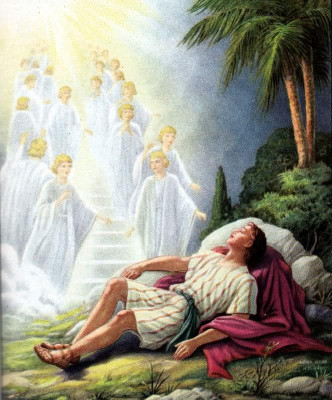 |
 18. Flint. Flint (a sacrificial flint knife) is another required step toward becoming like God. The Mayans said that on this day, the person is made perfect. Thus, my summary word is "Perfection". With the understanding that these later steps are all in the service of others, it would mean this sacrifice for others, such as paying their debts or saving them from disaster at great personal cost.
18. Flint. Flint (a sacrificial flint knife) is another required step toward becoming like God. The Mayans said that on this day, the person is made perfect. Thus, my summary word is "Perfection". With the understanding that these later steps are all in the service of others, it would mean this sacrifice for others, such as paying their debts or saving them from disaster at great personal cost.
The indicated Hebrew and Enoch holy day is the first day of the fifth month, a day associated with the Hebrew priest, who performed sacrifices according to the Law of Moses. For example, the Bible explicitly gives the date of the death of Aaron, the archetype of the Aaronic Priesthood, as being on that day (Num 33:38). That day has no special Hebrew name so it is called "Sacrifice" in my work.
The Star Calendar lunar mansion day may give a huge clue about just what that sacrifice might be. The star is "Deliverer" (Del Cnc) in the Crab, which represents one who delivers objects from the sea to land. It represents Christ in his role as the Deliverer of spirits from the spirit world (in the underworld represented by the sea) to be resurrected (back on land). This step of becoming like God might entail performing such a sacrifice to save others.
 19. Storm. The nineteenth glyph, Storm or Fire Storm, is called by different Native American tribes "storm", "rain", "rain of fire", "fire storm" or even simply "fire". It is opposite Water in the circle, suggesting either water from heaven or fire as opposite of water on earth. It is said to be when one's "divine nature is manifest." The concept of "Lightning" is my word to summarize the meaning of fire in the sky which manifests divinity during a rain storm. Hence lightning was included in my modern representation of Storm.
19. Storm. The nineteenth glyph, Storm or Fire Storm, is called by different Native American tribes "storm", "rain", "rain of fire", "fire storm" or even simply "fire". It is opposite Water in the circle, suggesting either water from heaven or fire as opposite of water on earth. It is said to be when one's "divine nature is manifest." The concept of "Lightning" is my word to summarize the meaning of fire in the sky which manifests divinity during a rain storm. Hence lightning was included in my modern representation of Storm.
The Hebrew and Enoch holy day would be the Summer Fast, which commemorates the burning of both the first temple (587 BC) and also the second (AD 70). Both occurred on the same day of the Hebrew year! Again we see the concept of fire and burning. In my work the name of that Hebrew holy day is "Burning".
As for the Star Calendar, the star day is "King" (Alp Leo), the bright star at the heart of the Lion, King of Beasts. It symbolizes Christ as King of Kings when He comes at the end of the world and destroys the proud and wicked by fire. That is certainly one aspect of the divine nature! In this case, many of the ones He is serving are the righteous whom He is enabling to live in peace during the Millennium. That is, one of the duties of a King is to protect His subjects.
 20. Flower. This glyph was called "Flower" by some tribes and "Lord" by others. The meaning is the day when one "becomes one with divinity". In my work the day sign is named Flower and the word summarizing meaning is "Lord". Again, as Jesus taught, he who would be the leader should be the servant of all.
20. Flower. This glyph was called "Flower" by some tribes and "Lord" by others. The meaning is the day when one "becomes one with divinity". In my work the day sign is named Flower and the word summarizing meaning is "Lord". Again, as Jesus taught, he who would be the leader should be the servant of all.
The Hebrew and Enoch holy day indicated is the first day of the 6th month, which is only a holy day by virtue of being the first day of a month. It has been clear to me that it is a more important holy day deserving its own name because it was the birthday of Noah. It is the traditional day that Moses ascended the mount the third time, at the season of the giving of the Ten Commandments. Thus, it has the name "Ascension" in my work because that fits the Native American symbolism perfectly too.
The Star Calendar day is "Heavenly" (Bet Vir) located in the wing of the Maiden. Her angel wings show that she is no ordinary woman, but is celestial in some sense. This is also a perfect match for represent becoming one with God.
Thus, all of these sacred calendars are clearly working together to tell a story about mankind's journey through life and thereafter. Now let us turn to my attempt to tie all of this together in one narrative.
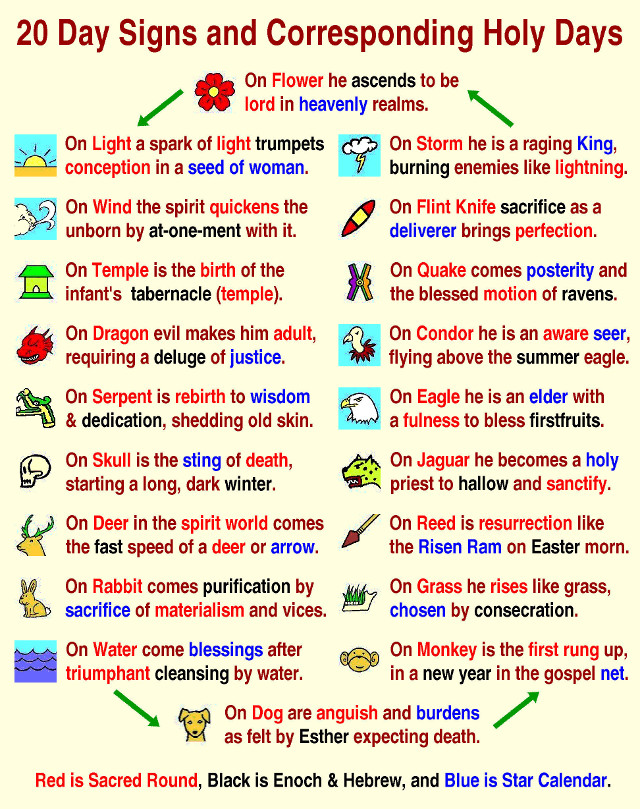 |
The discovery mentioned briefly above that the last seven day signs refer to serving others may have huge implications. One of those seems worthy of reporting here even though it was discovered even as this article was being written.
There are seven chief angels who serve God, often referred to as archangels. They have been identified and discussed earlier articles[8] and all are extremely important in sacred calendars. For example, each of the seven has seven constellations which refer to events in their lives.[9]
It now appears that each of these seven angels is also associated with one of the last seven day signs of the veintena. The following identification is only tentative in a work in progress. Let us consider all seven by asking relevant questions. The words in boldface italics in parentheses after each day sign name below is the name of the associated lunar mansion star day.
 |
In some sports there are different divisions of players according to their skill levels as they move up a ladder of expertise. There may be championships for A-level, B-level, and C-level players as well as for young and old. Spectators may cheer just as much for a hard-fought C-level match as for the top players. These seven angels can be compared to people on different rungs of the ladder fulfilling different services which they can perform at their skill level. A-players can cheer for the C-players, who will deserve the same recognition for their efforts as the champion of all (Mat. 20:12-13, 25:20-23). Moreover, if there is an assignment where the A, B, and C champions all work together to coach others in their respective classes, then they can work as a team even as do the seven angels.
Keeping in mind that earlier articles have already proposed that the seven chief angels in mortality were Adam, Abel, Enoch, Noah, Moses, Peter, and Joseph Smith, let us now attempt to correlate them with the last seven rungs of the veintena.
![]() Jaguar (Holy): Peter. Of the seven angels, which is associated most with getting people started up the ladder toward the celestial kingdom by accepting the gospel of Jesus Christ through baptism? Who was told he would become a fisher of men, casting out the gospel net? Who is the angel to whom the keys of the kingdom of heaven were given? Who is it most associated with the outward ordinance of the Jaguar Priest of baptism (see Figure 6)? Who is it who directed the restoration of the Aaronic Priesthood in these latter days (D&C 13 Heading)? Is it not Peter?
Jaguar (Holy): Peter. Of the seven angels, which is associated most with getting people started up the ladder toward the celestial kingdom by accepting the gospel of Jesus Christ through baptism? Who was told he would become a fisher of men, casting out the gospel net? Who is the angel to whom the keys of the kingdom of heaven were given? Who is it most associated with the outward ordinance of the Jaguar Priest of baptism (see Figure 6)? Who is it who directed the restoration of the Aaronic Priesthood in these latter days (D&C 13 Heading)? Is it not Peter?
![]() Eagle (Elder): Enoch. Of the seven angels, which are associated with the Eagle by having been born on 1 Eagle? Who became a translated being known as the messenger of God, represented by an eagle? Who is linked to the Melchizedek Priesthood by having been born on the star day "High Priest" (US), even as Melchizedek was also born on that day? Is it not Enoch?
Eagle (Elder): Enoch. Of the seven angels, which are associated with the Eagle by having been born on 1 Eagle? Who became a translated being known as the messenger of God, represented by an eagle? Who is linked to the Melchizedek Priesthood by having been born on the star day "High Priest" (US), even as Melchizedek was also born on that day? Is it not Enoch?
![]() Condor (Seer): Joseph the Seer. Of the seven angels, which is associated with being a seer so much that the word was part of his appellation? Who went like a lamb to the slaughter, putting his head into death in order to save others? Did not Perseus put on the helmet of invisibility (death) in order to slay the Medusa (Great and Abominable Church)? Which one died on the day of the brightest star in the heavens, Sirius, located in the Big Dog who hunts the adulterous Hare (Great and Abominable Church) in the netherworld? Is it not Joseph Smith, the Seer?
Condor (Seer): Joseph the Seer. Of the seven angels, which is associated with being a seer so much that the word was part of his appellation? Who went like a lamb to the slaughter, putting his head into death in order to save others? Did not Perseus put on the helmet of invisibility (death) in order to slay the Medusa (Great and Abominable Church)? Which one died on the day of the brightest star in the heavens, Sirius, located in the Big Dog who hunts the adulterous Hare (Great and Abominable Church) in the netherworld? Is it not Joseph Smith, the Seer?
![]() Quake (Posterity): Noah. Of the seven angels, which are the father of all living today? Which was born on the star day Posterity (US)? Which one released a raven on Raven Day? Is it not Noah?
Quake (Posterity): Noah. Of the seven angels, which are the father of all living today? Which was born on the star day Posterity (US)? Which one released a raven on Raven Day? Is it not Noah?
![]() Flint (Deliverer): Abel. Who was sacrificed as the main feature of his life? Who died on the day of the star among the seven in the Little Bear which represents the president of those on track to receive a telestial glory? Who sacrificed having any glory during mortality in order to spend millennia in the spirit prison attempting to deliver those in hell up to receive a better resurrection (telestial to terrestrial)? Is it not Abel?
Flint (Deliverer): Abel. Who was sacrificed as the main feature of his life? Who died on the day of the star among the seven in the Little Bear which represents the president of those on track to receive a telestial glory? Who sacrificed having any glory during mortality in order to spend millennia in the spirit prison attempting to deliver those in hell up to receive a better resurrection (telestial to terrestrial)? Is it not Abel?
![]() Storm (King): Adam. Of the seven angels, which was called "Prince" by his people (D&C 107:54)? Does not the ancient star name (Regulus) for the star corresponding to this day mean "Prince" (even though the name King is used in my work)? Is Michael (Adam) not the chief captain of the armies of the Lord (Rev. 12:7) who treads down the Lord's enemies including their burning at the Second Coming? Is it not Adam?
Storm (King): Adam. Of the seven angels, which was called "Prince" by his people (D&C 107:54)? Does not the ancient star name (Regulus) for the star corresponding to this day mean "Prince" (even though the name King is used in my work)? Is Michael (Adam) not the chief captain of the armies of the Lord (Rev. 12:7) who treads down the Lord's enemies including their burning at the Second Coming? Is it not Adam?
![]() Flower (Heavenly): Moses. Of the seven angels, which was born on 1 Flower? Which is associated with ascending the mountain to leave his people and be taken up by God? Who talked to God face to face, being one with the Lord like a friend (Exo. 33:11)? Whose angelic name means "friend of God" (Raguel)? Is it not Moses?
Flower (Heavenly): Moses. Of the seven angels, which was born on 1 Flower? Which is associated with ascending the mountain to leave his people and be taken up by God? Who talked to God face to face, being one with the Lord like a friend (Exo. 33:11)? Whose angelic name means "friend of God" (Raguel)? Is it not Moses?
These identifications seem clear enough to propose as tentative suggestions. My articles have vacillated back and forth between whether Moses died or was translated. Now the combined symbolism that he had to ascend the mountain and that he was born on the day 1 Flower has swayed me to believe that it seems clear that he was indeed translated.
What a wealth of information is hidden in these simple signs and symbols. And surely, we are only beginning to scratch the surface of what is hidden there!
The previously known fact that twenty holy days on Enoch and Hebrew Calendars correspond to the twenty day signs of the veintena was reviewed, along with the more recent discovery that the same is true of 20 of the 28 lunar mansion star days. These correspondences could not be by chance because all twenty of the holy days occur in the same order in every case.
The Mayans taught that these twenty steps in life are the rungs of two ladders, one with ten rungs coming down from heaven to hell and then ten more rungs on a ladder leading back up to heaven. It was noticed that this concept is very similar to the dream that Jacob had of angels descending and ascending on a ladder to heaven. Thus, the new perspective that all of the day signs of the veintena represented rungs on two ladders was considered. When charts were made with the day sign names and meanings, Enoch and Hebrew holy days, and corresponding Star Calendar lunar mansion holy days all shown together for each step, new interpretations of some day signs were achieved.
In particular, a new understanding of the last seven steps now has emerged. It had long been been noticed that the last seven seemed different from the first thirteen in some way. It had been proposed in earlier articles that they might represent ordinances, but that theory did not seem to work for all seven of those signs. Now it appears that those seven signs represent serving others in their personal journeys up the ladder, whereas all of the first thirteen steps were steps an individual could take alone.
With that new understanding and interpretation of the last steps, a brief summary was written. Moreover, a tentative correlation of each of the last seven steps to one of the chief angels was proposed. No definite conclusion was drawn about identifying the veintena circular ladder as identical to Jacob's ladder, but the possibility seems clear that they may be two very similar ways at looking at the steps to take to return to God.